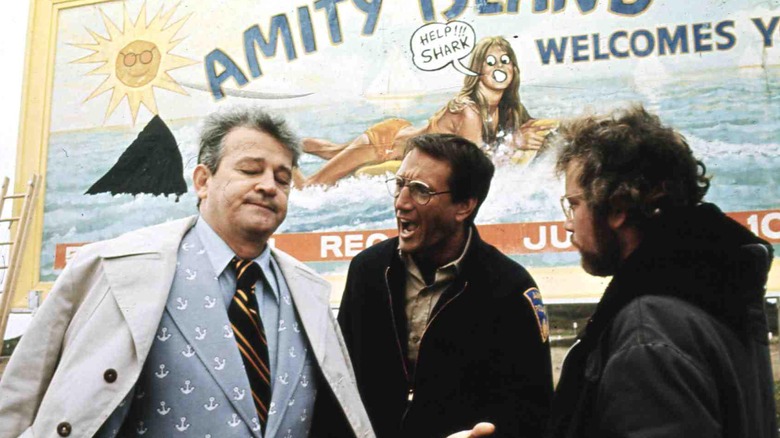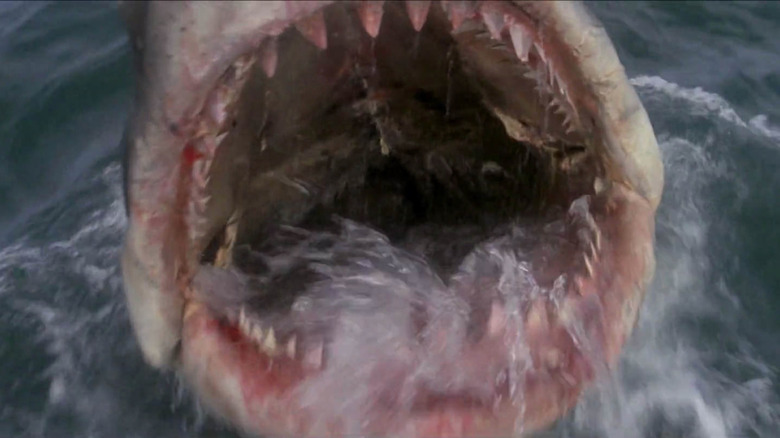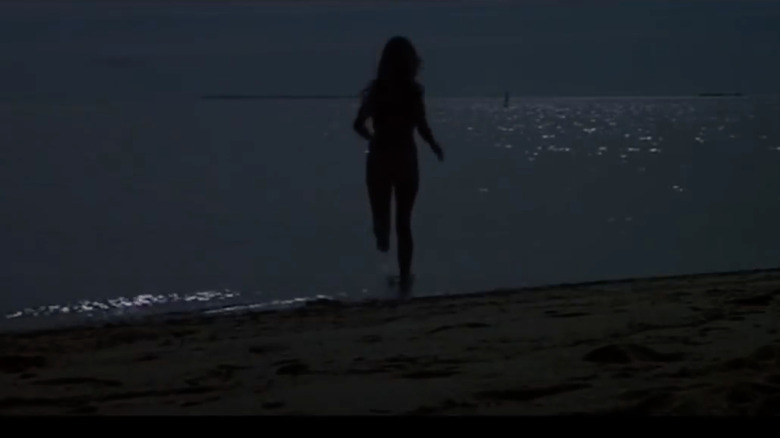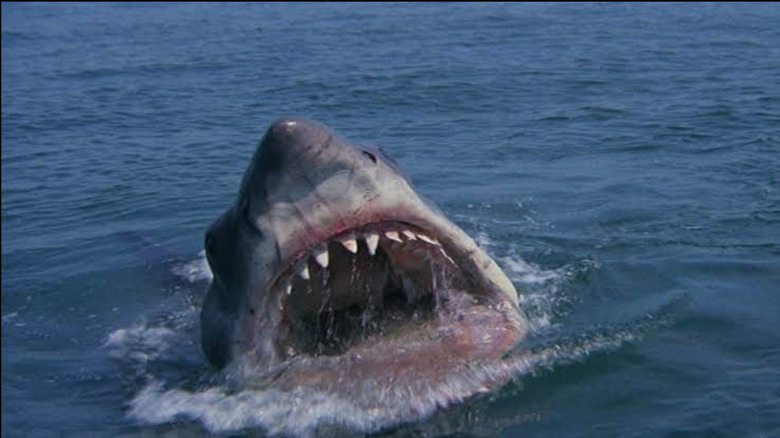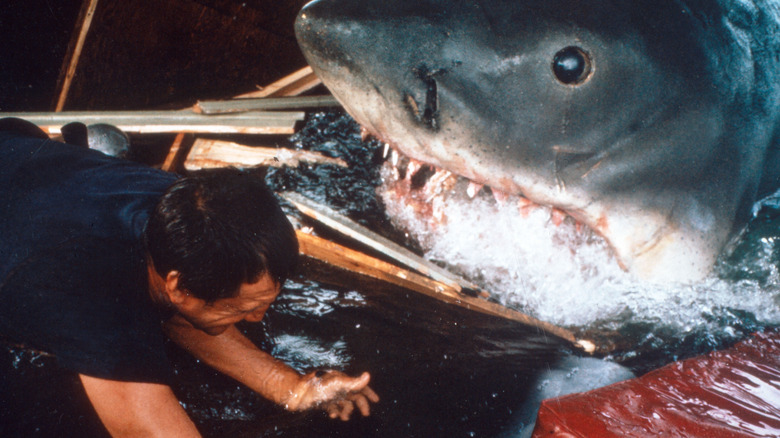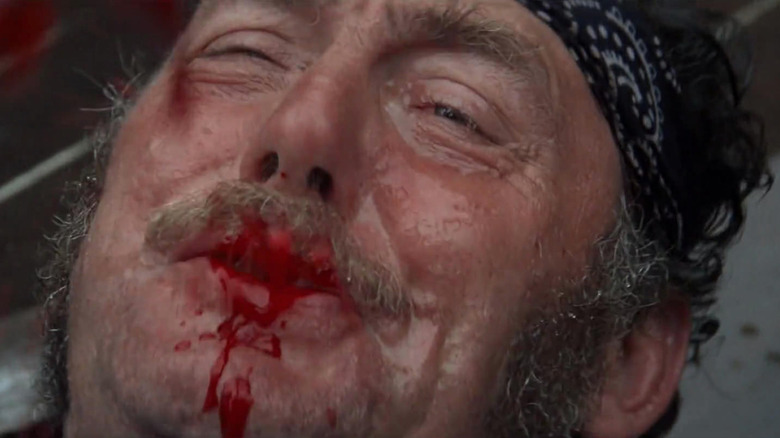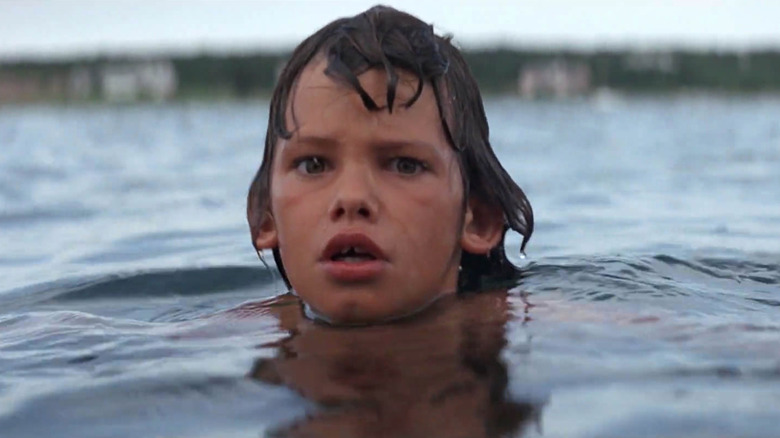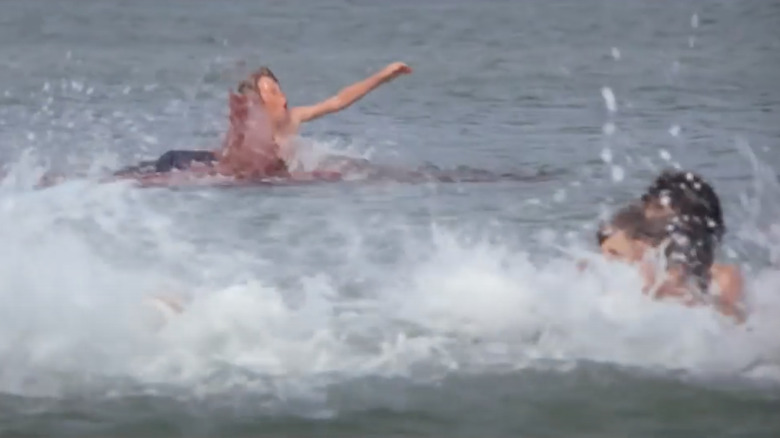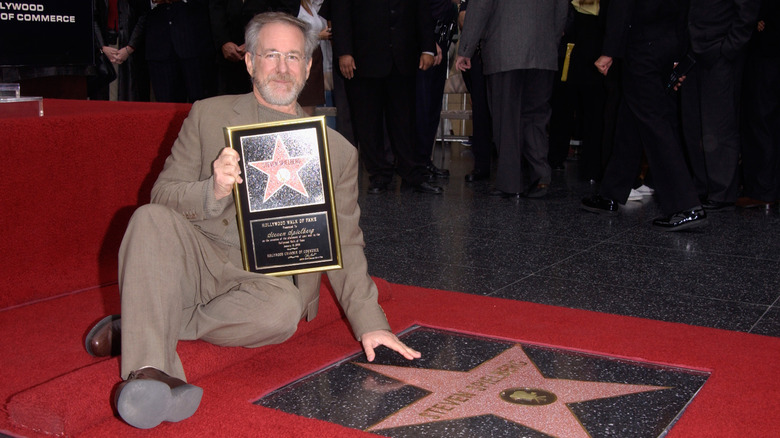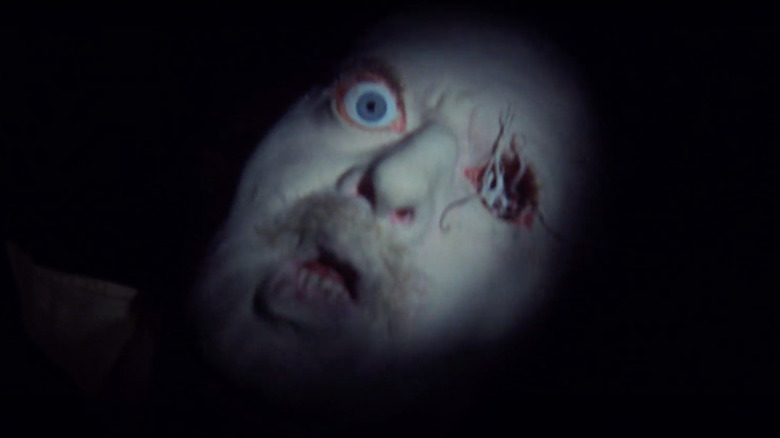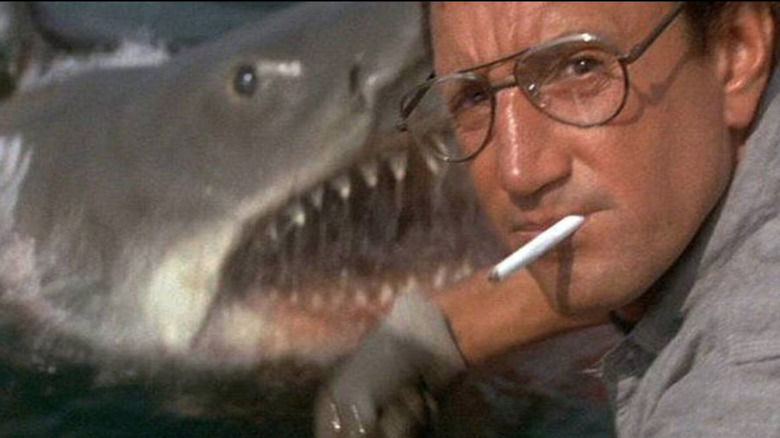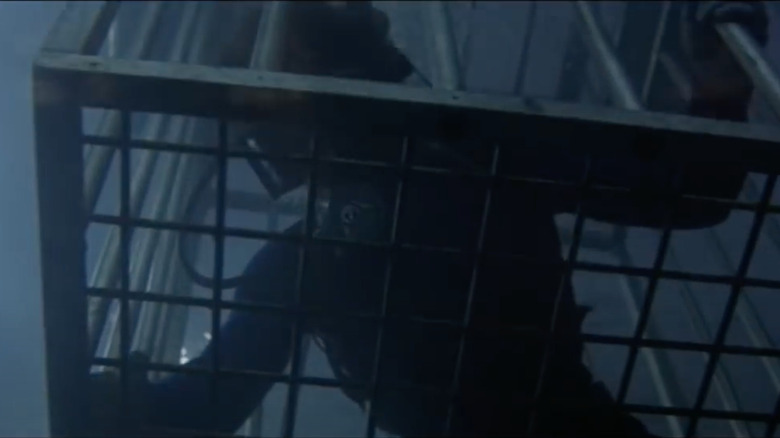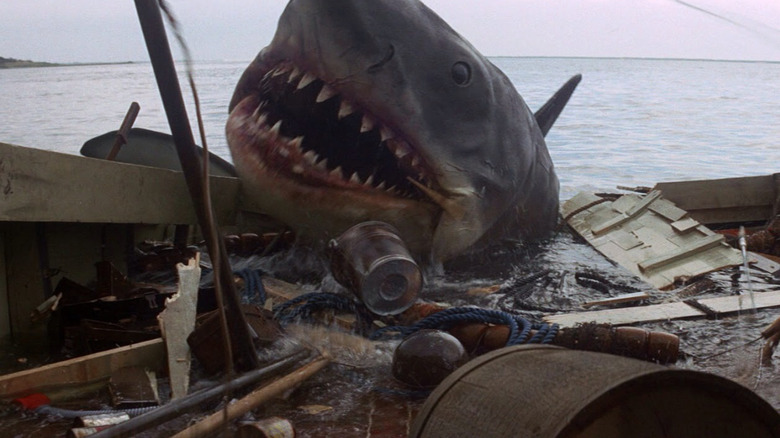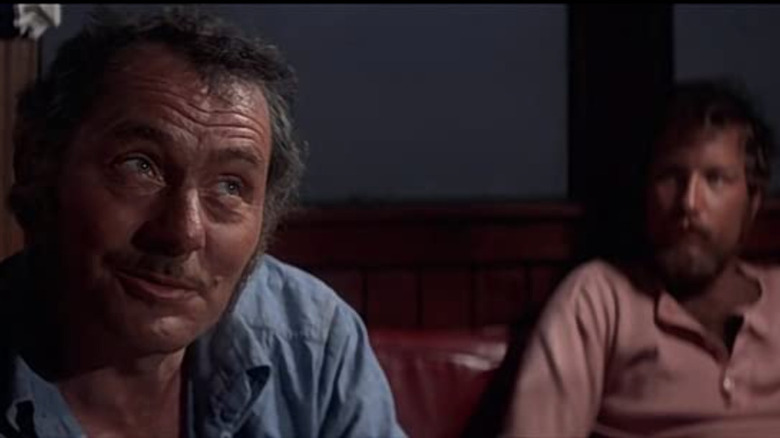Weird Things That Happened On The Set Of Jaws
"Jaws" was the inception of the summer blockbuster. When it terrorized theaters in 1975, the thrill spread like blood in the water, and soon, audiences were rushing to see it like the Fourth of July crowds on Amity Island.
While "Jaws" did take a bite out of the eponymous book by Peter Benchley (which was loosely based on a true story), it mostly deviates from Benchley's original plot, at least until the showdown in the end, according to Medium. Filming this behemoth of a movie almost swallowed the cast and crew. From fake-blood overload to a sinking boat, all sorts of bizarre things happened on set, though the most infamous might be those mechanical sharks that almost never functioned like they should have.
The Take argues that part of the massive success of "Jaws" might have come from what legendary director Steven Spielberg had to do to compensate for shark malfunctions. Using the brilliant "duh-dun duh-dun" soundtrack by John Williams and ominously bobbing objects to signal the presence of the shark created heart-pounding-in-your-throat suspense. Jump scares like the severed head floating in the water only added to the adrenaline rush.
Let's take a deep dive into what went wrong, what was unexpected, and what ultimately ended up drifting to the bottom of the ocean.
The original director was fired for calling the shark a whale
Before Steven Spielberg ever stepped onto the "Jaws" set, original director Dick Richards apparently couldn't get his species right.
The Digital Fix reports that he kept referring to the shark as a whale. For some unknown reason, Richards called the shark a whale over and over in meetings, much to the chagrin of Universal producers Richard D. Zanuck and David Brown, who had hired him. According to Mike Medavoy's book "You're Only as Good as Your Next One," the trouble started when Richards met with Zanuck, Brown, and "Jaws" author Peter Benchley at the "21" Club in New York City. Richards described his vision for the opening scene, which would involve an appearance by "the giant whale." Zanuck corrected him, but it didn't take — Richards kept calling the beast a whale, with Benchley reportedly growing angrier each time he did it.
Brown and Zanuck decided they couldn't put up with someone who apparently didn't know (or didn't care) about the difference between a whale and a shark. They fired Richards, who would go on to direct "Tootsie" several years later.
The actress who played the first victim was actually dragged underwater
For Susan Backlinie, the stuntwoman who played Chrissie Watkins, pretending to be a shark's dinner wasn't so easy as just waving her hands in desperation and screaming.
That fateful night that Chrissie decided to leave all her inhibitions on the beach and go skinny-dipping with her boyfriend would be her last. As The Daily Jaws reveals, the scene had more moving parts than what appeared just above the water. Backlinie was in jean shorts with a built-in harness that had three fasteners, attached to underwater cables, to keep her in place. These cables were manipulated from the beach to pull her from side to side as if she were really trapped in the mouth of a shark. The direction in which her hips were being pulled told her which way she should throw her arms up, and because the camera doesn't move, it gives the uneasy feeling of watching helplessly as she's devoured. She kept thrashing until the final pull took her all the way under, as if the shark had her.
Backlinie at least had a safety backup, according to Cinemablography. She only had to pull a string to free herself if the tugging from the cables became too much.
Bruce the animatronic shark often malfunctioned
"The shark never worked — it just never worked," veteran boat owner and operator Lynn Murphy is remembered saying in Patrick Jankiewicz's book "Just When You Thought It Was Safe: A Jaws Companion."
The issues with the three animatronic sharks (nicknamed "Bruce") that terrorized the big screen never seemed to end. You know those scenes where you see barrels bobbing ominously on the waves? They were shot on days when none of the sharks were behaving, whether they wouldn't do anything the way director Steven Spielberg wanted or couldn't "swim" fast enough. Sometimes their jaws refused to close (or open). Other times, their eyes crossed when they were only supposed to roll over when the shark sank its teeth into human flesh, something that happens with actual sharks when they bite into their prey.
The non-moving shark mounted on a sled was damaged when it sat at the bottom of the ocean for 30 days. Because it was made with iron and other materials, including plastic, brass, and aluminum, much of it inevitably corroded. It failed to work properly when it was finally dredged up from the depths for its star turn on camera. Shark issues ended up blowing up production costs, according to The Atlantic. The film went from a projected $4 million to bleeding $9 million.
The sharks were a monster pain to manipulate
The mechanical sharks used in "Jaws" were 25 feet long, as The Atlantic reports, and it took effort to subdue them into behaving. Two of the animatronic predators were one-sided creatures with their own power units that depended on pneumatics. Whichever side revealed the mechanics faced away from the camera. (The sled shark was just as huge but missing part of its underside.) Problems surfaced when salt water got into the tubes. Because these sharks were mounted on platforms, there was the issue of them sliding off sometimes. Both the platforms and pneumatics needed to behave so the sharks could be manipulated as if they were swimming.
"The ocean was so brutal on the mechanics," Roy Scheider, who played Amity Island police chief Martin Brody, told Universal Pictures All-Access. "All the pneumatic tubes, all of that special equipment was being dashed and brutalized by the ocean every day."
There might have been an omen of the problems that would later emerge. As Patrick Jankiewicz writes in "Just When You Thought It Was Safe," Spielberg showed Bruce off to George Lucas before filming began. Spielberg tested the controls in the shark's mouth with Lucas' head in the animatronic animal's teeth. It was easier to clamp the controls down than loosen the thing's jaws. They became stuck. Because Spielberg couldn't make Bruce surrender his prey, Lucas ended up having to yank his head out with the mouth still shut.
Someone got carried away with fake blood
As if that scene showing Quint slowly being eaten alive isn't gory enough, an outtake shows it was supposed to be even bloodier.
Robert Shaw was spared from being chomped by rows of sharp teeth. According to The New York Times, the Bruce models all had one set of soft teeth to keep shark attacks from being painful for actors and stuntmen. This original footage gives a glimpse of what Shaw went through. He had to thrash around as the shark's head moved from side to side, which might have caused the teeth to tear into him if they had been sharp. The footage also shows a screaming Quint caught in the shark's jaws, uncontrollably spewing blood from his mouth.
There might have been too much fake blood, according to The Hollywood Reporter. An overflow of the stuff covered part of Shaw's face when it spurted out, and some of the crew ended up laughing in the background. The final version of the scene is (slightly) tamer. "Jaws" was rated PG, even with its gruesome portrayal of a man being devoured.
That guy in the rowboat was supposed to end up in the shark's jaws
You know that scene where three boys are floating around on a paddleboat, ignoring the bloodcurdling screams of fear coming from everyone else at the beach because of a shark alert?
Ted Grossman was the stunt coordinator for "Jaws" as well as the stuntman in the rowboat who falls victim to the shark. He plays a Boy Scout leader who approaches the boys in his own boat to ask them if they are doing alright, and they must be since they seem completely oblivious to all the screaming. That was another scene that was originally meant to be much bloodier, according to CNN. Grossman was not only supposed to be pulled underwater and into the shark's gaping maw after his boat capsized, but also drag one of the young boys in with him.
"I got in the shark's mouth and they were taking me under the water, on top of the water, and there was blood all over the place," Grossman said. "And then I grab the kid and drag him under with me, but it was so shocking." The scene was instead filmed from the boy's point of view, his eyes opening wide in shock before the camera focuses on the scout leader's bloody, disembodied leg falling through the water.
Something blew up in another gory scene ... which was also tamed
Some scenes in "Jaws" will forever remain burned into your mind, and one of them shows the bloody fate of Alex Kintner, the boy who was paddling around on an inflatable raft.
If you think this scene, which suggests a child was eaten by the shark when the water turns alarmingly red, is nightmare fuel, the documentary "The Shark Is Still Working" reports it was supposed to be much more graphic. Just fast-forward to this part. Bruce was going to be shown chewing away at the child, and it was already storyboarded. Because subjecting a 12-year-old to the bite of a gargantuan mechanical shark was not exactly safe, a mannequin was used as a stunt double. That version of the scene was eventually scrapped.
When he was interviewed for the documentary, Jeffrey Voorhees, who played Alex, recalled he was given half a raft that was filled with fake blood and told to go underwater when it exploded, sending up a geyser of fake blood. The scene had to be shot four times, with stuntmen in wetsuits finally giving Voorhees an assist by pulling him downward to make it appear more realistic.
Shooting the film in the ocean almost sank Steven Spielberg's career
Steven Spielberg was adamant about capturing as many scenes as possible off the coast of Martha's Vineyard, according to Far Out Magazine, and insisted to the producers that it would make "Jaws" as realistic as possible. Unfortunately, the real problems that come with boating and diving and ocean water nearly drowned the young director's career. He still has no regrets decades later. "I was too young to know I was being foolhardy when I demanded that we shoot the film in the Atlantic Ocean and not in a North Hollywood tank," Spielberg told Ain't It Cool News. "But had I to do it all over again, I would have gone back to the sea."
He didn't completely bash movies made in tanks. In that same interview, he admitted that some movies, like "The Old Man and the Sea," benefitted from the "mythological feel" a tank gave them, but "Jaws" wasn't destined to be one of them. The crew had it as rough as actual fishermen. They suffered from bouts of seasickness and were burned by the sun, and the mechanical sharks never got along with the saltwater as well as their living brethren do.
Filming was just as grueling for Spielberg himself. He was asked to return for "Jaws 2" and "Jaws 3-D," but he was "done with the ocean" and couldn't imagine going through that adventure all over again.
The severed head was soaked in milk and bobbing in a swimming pool
Another thing in "Jaws" that was destined to keep many pairs of eyes wide open all night was that scene where Brody and Hooper run into fisherman Ben Gardner's boat, and then his head — just his head. Its one lifeless eye (the other had been ripped from its socket) stares emptily at Hooper when he encounters it on a dive for shark-attack evidence.
The scene is shrouded in ocean mist as if it had been shot on the open water, and it looks as if Hooper is screaming underwater in the murky depths. But the whole thing was actually done in a backyard swimming pool, as screenwriter and actor Carl Gottlieb told Patrick Jankiewicz in "Just When You Thought It Was Safe." What became known as the "head scene" had to be reshot because Spielberg wasn't feeling it. The budget was already being drained by the mechanical sharks and other glitches, but the director found his solution in film editor Verna Fields' pool and offered to pay for the reshoot out of pocket (per The New York Times). They plunked the head and boat into the pool, and dumping milk into the water gave it a murky look.
"They put the boat and head in, threw a couple quarts of milk in to make the water look milky and textured, so it would catch the light correctly," said Gottlieb about what he referred to as "the biggest shock in 'Jaws.'"
'You're gonna need a bigger boat' was sort of improvised
This trademark line from "Jaws" wasn't written into the script. According to The Hollywood Reporter, it started out as a phrase the cast and crew would throw around when things went wrong on set (which turned into a common occurrence).
Because producers Richard D. Zanuck and David Brown kept holding back on spending for the film, "You're going to need a bigger boat" was something they heard over and over again. Roy Scheider would randomly throw it in on camera. Those takes were cut, except for the one that would end up being eternally quoted. When Scheider was reading for the scene in which the shark's menacing head first appeared both to him and the audience as he was tossing bait out on the deck of the Orca, he ad-libbed the line into the scene, and it stuck.
So how big was the Orca, anyway? According to Mental Floss, Quint's fictional boat was 42 feet long, which would have had nothing on a 25-foot shark if that fiberglass monster had been the real deal. In the scene, you can hear Quint confidently saying the thing must weigh some three tons as he gazes out into the ocean. They would have indeed needed a much bigger boat.
An actual shark encounter changed the ending
Before the "Jaws" crew started wrangling animatronic sharks, they needed to capture footage of real great whites swimming for the scene where Hooper is lowered down in a shark-proof cage to investigate. Shark expert Valerie Taylor was on board when the crew decided to film at South Australia's appropriately named Dangerous Reef, a feeding ground for this species of shark.
Taylor told Inside Hook that the sharks they found were around 15 feet long — 10 less than the leviathan that salty old Quint swore he would take down — so things had to be scaled down for filming the cage scene. To make the sharks look bigger, the shark-footage team used a small boat, built a smaller shark cage, and found a short actor to serve as Hooper's stunt double. But he had no diving experience and was nervous about being surrounded by so many sets of jaws. He was fortunate enough not to have been in the cage when one shark came too close.
"A huge 16-foot great white got caught in the wench that was connected to the cage," Taylor said. "The shark started thrashing around, the wench broke off... the cage was destroyed."
Not forcing the actor to go down there saved his life, as there was no way he would have survived that. But the dramatic footage of the shark attack was still used, and according to "Jaws: The Inside Story," that changed the story from Hooper dying in the cage (which is what happened in the book) to escaping at the last second.
The Orca kept sinking
Quint's already-battered boat didn't hold up that well, and not just because a shark chomped down on it.
There were actually two Orcas used for the film, as Mental Floss reports. Orca I was a bona fide lobster fishing boat previously known as the Warlock. After production designer Joe Alves bought it for the film, it underwent a massive facelift to look more like a shark-hunting boat. Orca II was basically Orca I's stunt double. Made of fiberglass, like the sharks, and powered by a complex system of hydraulics that could make it look like it was being flung about by the water, it could sink on command.
The problem with a boat that sinks on command is that sometimes, it sinks a little too easily. This happened more than once. It wasn't just the boat that sank, but two outrageously expensive cameras that happened to be on board, which the studio had rented for the production. During an appearance on "Later with Bob Costas" (per "Just When You Thought It Was Safe"), Richard Dreyfuss remembered one Orca sinking incident that had a panicked Steven Spielberg calling all the actors off the boat through a megaphone.
There was an epic feud on set
They were supposed to work together as Quint and Hooper, but just as their onscreen relationship was fraught with problems, Robert Shaw and Richard Dreyfuss did not get along while filming "Jaws," as the BBC reveals.
The clash between the two actors was so intense that Steven Spielberg even referred to it as "the great Shaw-Dreyfuss feud." Shaw was supposedly harmless off set. It was when he was on set that he morphed into a bully of sharklike proportions. He tried to harass Dreyfuss (who he thought was inexperienced) into taking on dares like climbing to the top of the Orca's mast and jumping off. Whatever Shaw's intentions were — whether he was getting into character or just turned cantankerous near the ocean — butting heads with Dreyfuss might have fed into their characters' on-screen rivalry and made it that much more believable.
In an interview with Universal Pictures All-Access, Dreyfuss remembers both the brilliant and the ugly sides of Shaw. He would push the younger actor further physically, acting as if he doubted Dreyfuss was capable of things just so he could get more out of him. "I Iiked him and I hated him," Dreyfuss said. "He had my number, you know. He could get me, and he always did."
